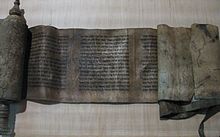
Back Ester (Bybel) Afrikaans سفر إستير Arabic سفر استير ARZ Ester (Buach) BAR Buku Ester BBC Кніга Эсфір Byelorussian Книга Естир Bulgarian Levr Ester Breton Llibre d'Ester Catalan Ī-sê̤ṳ-táik Cṳ̆ CDO
 | |||||
| Tanakh (Judaism) | |||||
|---|---|---|---|---|---|
|
|
|||||
| Old Testament (Christianity) | |||||
|
|
|||||
| Bible portal | |||||

The Book of Esther (Hebrew: מְגִלַּת אֶסְתֵּר, romanized: Megillat Ester; Greek: Ἐσθήρ; Latin: Liber Esther), also known in Hebrew as "the Scroll" ("the Megillah"), is a book in the third section (Ketuvim, כְּתוּבִים "Writings") of the Hebrew Bible. It is one of the Five Scrolls (Megillot) in the Hebrew Bible and later became part of the Christian Old Testament. The book relates the story of a Jewish woman in Persia, born as Hadassah but known as Esther, who becomes queen of Persia and thwarts a genocide of her people.
The story takes place during the reign of King Ahasuerus in the First Persian Empire. Queen Vashti, the wife of King Ahasuerus, is banished from the court for disobeying the king's orders. To find a new queen, a beauty pageant is held and Esther, a young Jewish woman living in Persia, is chosen as the new queen. Esther's cousin Mordechai, who is a Jewish leader, discovers a plot to kill all of the Jews in the empire by Haman, one of the king's advisors. Mordechai urges Esther to use her position as queen to intervene and save their people. Esther reveals her Jewish identity to the king and begs for mercy for her people. She exposes Haman's plot and convinces the king to spare the Jews. The Jewish festival of Purim is established to celebrate the victory of the Jews of the First Persian Empire over their enemies, and Esther becomes a heroine of the Jewish people.
The books of Esther and Song of Songs are the only books in the Hebrew Bible that do not mention God explicitly.[2] Traditional Judaism views the absence of God's overt intervention in the story as an example of how God can work through seemingly coincidental events and the actions of individuals.
The book is at the center of the Jewish festival of Purim and is read aloud twice from a handwritten scroll, usually in a synagogue, during the holiday: once in the evening and again the following morning. The distribution of charity to the needy and the exchange of gifts of foods are also practices observed on the holiday that are mandated in the book. Since the 1890s, there has been a general consensus among scholars that the narrative of Esther was written to provide an etiology for Purim’s origin as a Babylonian or Persian festival.[3][4][5]
- ^ Rossel, Seymour (2007). The Torah: Portion by Portion. Los Angeles: Torah Aura Productions. p. 212. ISBN 978-1-891662-94-2.
- ^ Blumenthal, David R. "Where God is Not: The Book of Esther and Song of Songs". Archived from the original on January 17, 2019. Retrieved April 19, 2016.
- ^ Moore, Carey A. (1971). Esther. Doubleday. See section “The Non-Jewish Origins of Purim.” Pages 46-49. “Esther's canonical status may have been opposed by those Jews who saw the book as a defense for a Jewish festival which, as its very name suggests (*the pûr [that is, the lot]", iii 7; see also ix 26), was non-Jewish in origin. Certainly modern scholars have felt the explanation for Purim's name in ix 26 to be strained and unconvincing. Moreover, the ‘secular" character of the feast suggests a pagan origin, that is, no prayers or sacrifices are specified, but drinking to the point of excess is permitted in the Talmud, Megilla 7b… pûrim is a hebraized form of a Babylonian word...Efforts to identify Purim with an earlier Jewish or Greek festival have been neither common nor convincing, and ever since the 1890s, when Heinrich Zimmern and Peter Jensen equated Mordecai and Esther with the Babylonian gods Marduk and Ishtar, and Haman and Vashti with the Elamite gods Humman and Mashti, a Babylonian origin for Purim has been popular. Though scholars like Jensen, Zimmem, Hugo Winckler, Bruno Meissner and others have each picked a different Babylonian myth or festival as the prototype for Purim, namely, the Gilgamesh Epic, the Babylonian Creation Story, the Tammuz-Ishtar Myth, and the Zagmuk Feast, respectively, they all agreed in seeing Esther as a historicized myth or ritual. More recently, however, a Persian origin for Purim has been gaining support among scholars.”
- ^ Moore, Carey A. “Esther, Book of,” ed. David Noel Freedman, The Anchor Yale Bible Dictionary (New York: Doubleday, 1992), 637-638 “Certainly a pagan origin for Purim would also help to explain the "secular" way in which it was to be celebrated, i.e., with uninhibited and even inebriated behavior (cf. above Meg. 7b). Then too, a pagan origin for the festival would also help to explain the absence of various religious elements in the story…. But even more recently scholars are again looking to Palestine for the origin of the festival… Its Lack of Historicity: [R]are is the 20th-century scholar who accepts the story at face value.”
- ^ Browning, W. R. F., ed. (2009). "Ahasuerus". A Dictionary of the Bible (2nd ed.). Oxford University Press. doi:10.1093/acref/9780199543984.001.0001. ISBN 978-0-19-954398-4. Archived from the original on 2020-09-03. Retrieved 2020-04-17.
The story is fictitious and written to provide an account of the origin of the feast of Purim.